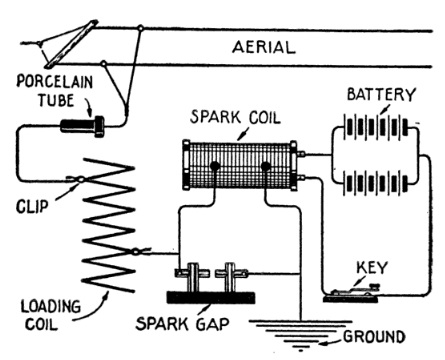A hundred years ago, the October 1916 issue of Popular Science gave detailed instructions for constructing a transmitter capable of sending one mile, the diagram of which is shown above. The set was powered by nine volts, consisting of twelve dry cells wired in series-parallel.
When the modern reader looks at a diagram such as this one, it’s not readily apparent how the set could actually work, since one critical part of the transmitting coil is not shown. The article noted that plans for constructing the coil were available in many books, but recommended that it was simpler and cheaper to simply buy one. It suggested an automotive spark coil, which could be obtained from a garage or electrician at nominal price. The article noted that even a new coil would cost no more than three or four dollars.
Such a coil is actually a transformer, and the primary is wired at the factory in series with an normally-closed interrupter. When the coil is energized by the nine volts, it creates a magnetic field, which opens the interrupter contact. This breaks the circuit, and the coil de-energizes, which results in the interrupter closing again, allowing the process to repeat. The net result is that an interrupted direct current is produced in the primary, and this induces an alternating current in the secondary. The secondary is a large enough voltage to make a one-inch spark in the attached spark gap.
 The spark gap, shown here, is constructed from two pieces of zinc mounted on a hardwood base boiled in paraffin. The key could be an ordinary telegraph key, which sold for about 75 cents, or could be homemade.
The spark gap, shown here, is constructed from two pieces of zinc mounted on a hardwood base boiled in paraffin. The key could be an ordinary telegraph key, which sold for about 75 cents, or could be homemade.
 The article stressed that the loading coil, shown here, was required to keep the transmitter on the correct wavelength, below 200 meters, to comply with federal law. It was constructed between two square boards, about 12 by 12 inches. FInally, an aerial of no more than 75 feet was required, and the article contained pointers for its installation as well.
The article stressed that the loading coil, shown here, was required to keep the transmitter on the correct wavelength, below 200 meters, to comply with federal law. It was constructed between two square boards, about 12 by 12 inches. FInally, an aerial of no more than 75 feet was required, and the article contained pointers for its installation as well.
Finally, the article described operation of the set:
Whenever the key is pressed, if the set is properly connected and adjusted, a bright, snappy, singing spark will jump across the gap. Each spark starts a train of high frequency currents oscillating back and forth in the aerial wires, and a train of electromagnetic waves is radiated into space. A suitable wireless receiver located where a portion of these radiated waves will reach it, will pick up some of their energy and produce from it a sound which indicates the dot-and-dash buzzes of a Morse signal.

